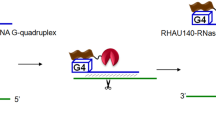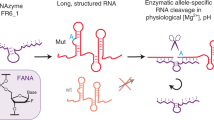Abstract
A small catalytic DNA, known as the 10–23 DNA enzyme or deoxyribozyme, has been shown to efficiently hydrolyze RNA at purine-pyrimidine (R-Y) junctions in vitro. Although these potentially cleavable junctions are ubiquitous, they are often protected from deoxyribozyme activity by RNA secondary structure. We have developed a multiplex cleavage assay for screening the entire length of a target RNA molecule for deoxyribozyme cleavage sites that are efficient, both in terms of kinetics and accessibility. This strategy allowed us to simultaneously compare the RNA cleaving activity of 80 deoxyribozymes for a model target gene (HPV16 E6), and an additional 60 deoxyribozymes against the rat c-myc target. The human papilloma virus (HPV) target was used primarily to characterize the multiplex system and determine its validity. The c-myc target, coupled with a smooth muscle cell proliferation assay, allowed us to assess the relationship between in vitro cleavage efficiency and c-myc gene suppression in cell culture. The multiplex reaction approach streamlines the process of revealing effective deoxyribozymes in a functional assay and provides accessibility data that may also be applicable to site selection for other hybridization-based agents.
This is a preview of subscription content, access via your institution
Access options
Subscribe to this journal
Receive 12 print issues and online access
$209.00 per year
only $17.42 per issue
Buy this article
- Purchase on Springer Link
- Instant access to full article PDF
Prices may be subject to local taxes which are calculated during checkout






Similar content being viewed by others
References
Santoro, S.W. & Joyce, G.F. A general purpose RNA-cleaving DNA enzyme. Proc. Natl. Acad. Sci. USA 94, 4262 –4266 (1997).
Milner, N., Mir, K.U. & Southern, E.M. Selecting effective antisense reagents on combinatorial oligonucleotide arrays. Nat. Biotechnol. 15, 537–541 (1997).
Lima, W.F., Brown-Driver, V., Fox, M., Hanecak, R. & Bruice, T.W. Combinatorial screening and rational optimization for hybridization to folded hepatitis C virus RNA of oligonucleotides with biological antisense activity. J. Biol. Chem. 272, 626–638 (1997).
Birikh, K.R., Berlin, Y.A, Soreq, H. & Eckstein, F. Probing accessible sites for ribozymes on human acetylcholinesterase RNA. RNA 3, 429–437 (1997).
Ho, S.P. et al. Potent antisense oligonucleotides to the human multidrug resistance-1 mRNA are rationally selected by mapping RNA-accessible sites with oligonucleotide libraries. Nucleic Acids Res. 24, 1901– 1907 (1996).
Ho, S.P. et al. Mapping of RNA accessible sites for antisense experiments with oligonucleotide libraries. Nat. Biotechnol. 16, 59– 63 (1998).
Matveeva, O., Felden, B., Audlin, S., Gesteland, R.F. & Atkins, J.F. A rapid in vitro method for obtaining RNA accessibility patterns for complementary DNA probes: correlation with an intracellular pattern and known RNA structures. Nucleic Acids Res. 25, 5010–5016 (1997).
Lieber, A. & Strauss, M. Selection of efficient cleavage sites in target RNAs by using a ribozyme expression library. Mol. Cell Biol. 15, 540–55 (1995).
Campbell, T.B. & Cech, T.R. Identification of ribozymes within a ribozyme library that efficiently cleave a long substrate RNA. RNA 1, 598–609 (1995).
Sugimoto, N. et al. Thermodynamic parameters to predict stability of RNA/DNA hybrid duplexes. Biochemistry 34, 11211– 11216 (1995).
Simons, M., Edelman, E.R. & Rosenberg, R.D. Antisense proliferating cell nuclear antigen oligonucleotides inhibit intimal hyperplasia in a rat carotid artery injury model. J. Clin. Invest. 93, 2351–2356 (1994).
Lima, W.F., Monia, B.P., Ecker, D.J. & Freier, S.M. Implication of RNA structure on antisense oligonucleotide hybridisation kinetics. Biochemistry 31, 12055–12061 (1992).
Ratmeyer, L., Vinayak, R., Zhong, Y.Y., Zon, G. & Wilson, W.D. Sequence specific thermodynamic and structural properties for DNA·RNA duplexes. Biochemistry 33, 5298–5304 (1994).
Gyi, J.I., Lane, A.N., Conn, G.L. & Brown, T. Solution structures of DNA·RNA hybrids with purine-rich and pyrimidine rich strands: Comparison with homologous DNA and RNA duplexes. Biochemistry 37, 73–80 (1998).
Inoue, H. et al. Synthesis and hybridization studies on two complementary nona(2´-O-methyl)ribonucleotides. Nucleic Acids Res. 15, 6131– 6148 (1987).
Majlessi, M., Nelson, N.C. & Becker, M.M. Advantages of 2´-O-methylribonucleotide probes for detecting RNA targets. Nucleic Acids Res. 26, 2224–2229 (1998).
Bielinska, A., Kukowska-Latallo, J.F., Johnson, J., Tomalia, D.A. & Baker, J.R. Jr. Regulation of in vitro gene expression using antisense oligonucleotides or antisense expression plasmids transfected using starburst PAMAM dendrimers. Nucleic Acids Res. 24, 2176–2182 (1996).
Le Tinevez, R., Mishra, R.K. & Toulme, J.J. Selective inhibition of cell-free translation by oligonucleotides targeted to a mRNA hairpin structure. Nucleic Acids Res. 26, 2273–2278 (1998).
Murray, V. Improved double-stranded DNA sequencing using the linear polymerase chain reaction. Nucleic Acids Res. 17, 8889 (1989).
Hendry, P., McCall, M.J., Santiago, F.S. & Jennings, P.A. A ribozyme with DNA in the hybridising arms displays enhanced cleavage ability. Nucleic Acids Res. 21, 5737– 5741 (1992).
Author information
Authors and Affiliations
Corresponding author
Rights and permissions
About this article
Cite this article
Cairns, M., Hopkins, T., Witherington, C. et al. Target site selection for an RNA-cleaving catalytic DNA. Nat Biotechnol 17, 480–486 (1999). https://doi.org/10.1038/8658
Received:
Accepted:
Issue Date:
DOI: https://doi.org/10.1038/8658
This article is cited by
-
Egr-1 functions as a master switch regulator of remote ischemic preconditioning-induced cardioprotection
Basic Research in Cardiology (2020)
-
Probe computing model based on small molecular switch
BMC Bioinformatics (2019)
-
Therapeutic Potential of DNAzyme Loaded on Chitosan/Cyclodextrin Nanoparticle to Recovery of Chemosensitivity in the MCF-7 Cell Line
Applied Biochemistry and Biotechnology (2019)
-
Fluorometric determination of zinc(II) by using DNAzyme-modified magnetic microbeads
Microchimica Acta (2018)
-
Novel Chemically-modified DNAzyme targeting Integrin alpha-4 RNA transcript as a potential molecule to reduce inflammation in multiple sclerosis
Scientific Reports (2017)



